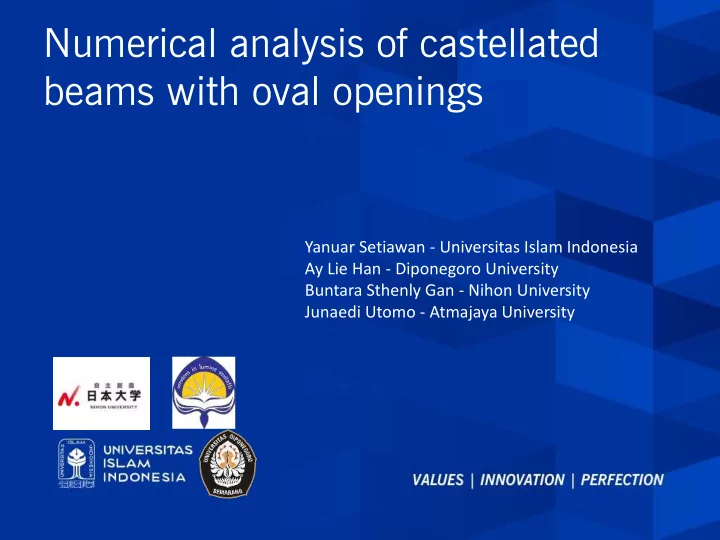

Numerical analysis of castellated beams with oval openings Yanuar Setiawan - Universitas Islam Indonesia Ay Lie Han - Diponegoro University Buntara Sthenly Gan - Nihon University Junaedi Utomo - Atmajaya University
Introduction • The main idea for the use of castellated beams is to reduce the self-weight by providing openings in the web of wide flange (WF), or I sections and re- arranging the cut section so that it result in an increase of height. • Numerous research on castellated beams has been conducted, the majority of the studies aimed to optimize the opening size and the shape configuration of the openings. Page 2
• The accomplished studies indicated that the stress concentration occurs in the corners of the openings leading to initial yielding in the section at the hexagonal opening. • Previous research on oval openings indicate that this form provides a greater load capacity compared to the hexagonal forms. Page 3
Experimental test • Steel properties test Tegangan σ ( MPa) Tegangan σ ( MPa) 550 500 440 400 330 300 Average Average Web 1 220 Web 1 200 web 2 Web 2 Flange 1 Flange 1 110 100 Flange 2 Flange 2 0 0 0 0.005 0.01 0.015 0.02 0.025 0.03 0 0.005 0.01 0.015 0.02 0.025 0.03 Regangan ε Regangan ε Stress-strain in tension of the WF 350x175 Stress-strain in tension of the WF 200x100 Page 4
Experimental test • Validation specimen Specification of specimen’s geometric variations b Dimension ( mm ) t flange Parameter CB - 1 CB - 2 CB - 3 CB - 4 ` t web Beamlength ( L ) 515 900 900 1600 D Beam width (B) 100 100 175 175 Beam height ( D ) 277 277 485 485 Ratio D/L 0,54 0,30 0,54 0,30 ` Height of the opening ( Do ) 180 180 315 315 b flange L/3 L/3 Ratio Do/D 0,65 0,65 0,65 0,65 L Width of the opening ( b ) 83 83 145 145 Ratio b/Do 0,46 0,46 0,46 0,46 Specimen designation Distance between opening (S) 113 113 206 206 Page 5
Experimental test • Validation specimen Load Cell 500 kN Load Cell 500 kN Load Beam Load Beam IWF 150x100 mm IWF 150x100 mm Steel D40 Strain Gauge ST Rosset LVDT HR LVDT HL 277 LVDT VR LVDT VL Acrylic Base Strain Gauge LVDT SC 100 100 144.5 226 144.5 100 Page 6
Numerical analysis • Material behavior and failure criteria The material of the castellated beams σ 1 was assumed to be isotropic, and the Von Misses criteria stress-strain relationship obtained from +σ yield Safe element the steel tensile test was used to +σ yield - σ yield accommodate the nonlinear steel σ 2 material behavior. The steel material Tresca - σ yield failure criteria used in the analyses Yielded element were based on the Von Misses failure envelope. Von Misses failure criterion Page 7
Numerical analysis • Finite element model The plate element used in this work was a six-node triangular plate element. The elements have quadratic shape functions. The quadratic element has the ability to accommodate curved edges, as a quadratic curve is fitted through the three nodes along the edges. This element type is very suitable for modeling the castellated beam with oval-shaped openings [12, 13]. The mesh size was set at 10 mm to ensure a good meshing and enhance the FEM of the castellated beam convergence rate. Page 8
Test result and numerical model validation • Validation of load-displacement response Applied Load (kN) 180 Applied Load (kN) 200 150 160 120 120 FEM CB2 90 Exp CB2 FEM CB1 80 Exp CB1 60 40 30 0 0 0.00 1.00 2.00 3.00 4.00 0.00 5.00 10.00 15.00 Displacement (mm) Displacement (mm) Applied Load (kN) 550 Applied Load (kN) 600 500 500 450 400 400 350 FEM CB4 300 300 Exp CB4 250 FEM CB3 200 200 Exp CB3 150 100 100 50 0 0 0.00 5.00 10.00 15.00 20.00 25.00 0.00 2.00 4.00 6.00 8.00 Displacement (mm) Displacement (mm) Page 9
Test result and numerical model validation • Comparison deformation of finite element model with deformation of the tested specimen Y X Z Page 10
Test result and numerical model validation • Deviation in bottom flange behavior between the FEM and the experimental specimen Page 11
Conclusions • The performed validation procedure to the load- displacement response of the Castellated steel beam, as well as the visual evaluation of the failure mechanism, showed that the constructed FEM could properly represent the specimen. • A deviation between the FEM and the experimentally tested specimen was distinguished at the bottom flange. • At further stages, this FEM will function to optimize the opening’s configuration, size and distance as well as be used to evaluate the principal stress flow and strain responses at every loading stages. The model will also be used to evaluate stress concentrations in the web. Page 12
Thank You Page 13
Recommend
More recommend